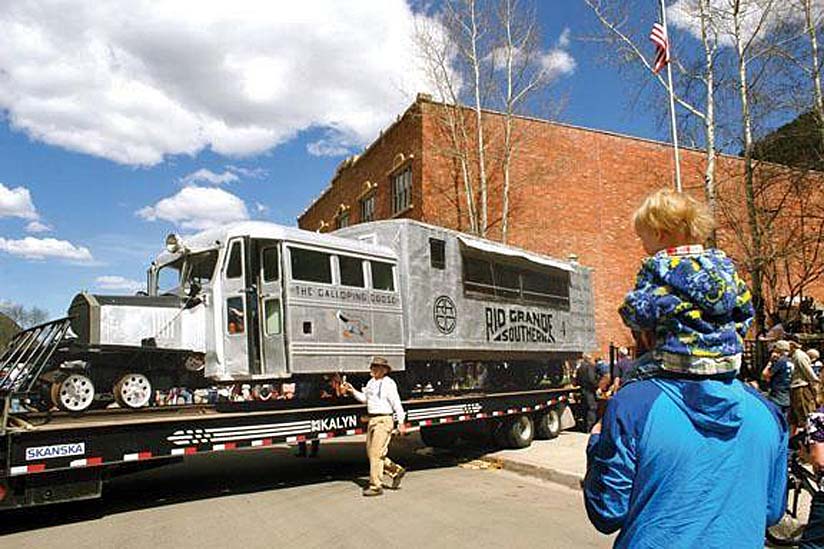
Telluride Colorado USA - Galloping Goose No. 4, a quirky gas-powered rail bus that once hauled mail, freight, and passengers up and down the famed Rio Grande Southern Railroad, has returned to its nest.
Previously displayed next to the San Miguel County Courthouse, the Goose spent the last four years at the Ridgway Railroad Museum undergoing a major restoration project.
The Goose, which is one of a fleet of seven rail buses built in the 1930s, was sent to Ridgway in 2008 after major faults were discovered in its structure.
The restoration was competed last fall.
On Thursday morning, the Goose looking smart under a new coat of paint, was loaded onto a special flatbed truck with rails, hauled over Dallas Divide, and carted up Colorado Avenue in Telluride, where a crowd gave it a warm welcome home.
The next step, transferring the rail bus to its former home on a set of elevated rails next to the courthouse, was a little tricky.
The rails had to be lined up precisely so the Goose could drive off the truck onto its perch, which entailed a great deal of backing up and inching forward.
Despite that, there was no shortage of interest, the crowd only grew as more people amassed to watch the move and take photos.
When the Goose finally came to a resting place on its rails, applause erupted.
The Goose returned the gesture with a few celebratory bleats of its horn.
"It's nice to have it back," said Jamey Schuler, chief of the Telluride Volunteer Fire Department, which owns the Goose and paid for the restoration.
"I'm happy it's here. It is so neat."
The Goose, a skinny, silver, contraption that looks like a cross between a truck and rail car, has a long and storied history in the San Juan Mountains.
The Rio Grande Southern Railroad was built in 1890 by Otto Mears to haul ore from the mines of southern Colorado.
But the railroad was hobbled by subsequent setbacks like the silver crash of 1893, and by 1930, it was suffering from the effects of the Depression.
The Rio Grande Southern hatched the concept for rail buses around that time as a way to cut costs.
The idea was that a gas-powered bus/train would require a smaller crew and less maintenance.
The first one was built in 1931.
"The first prototype that they built paid for itself in three weeks," said Jim Pettengill of the Ridgway Railroad Museum, who helped in the restoration.
Galloping Goose No. 4 is one of seven total that were built in Ridgway shops.
In the early years, it carried mail, passengers, and light freight between Ridgway and Durango.
Pettengill said the Geese were so cost-effective that they allowed the RGS to stay in business for another 20 years.
But by 1950, loss of the mail contract, and improved highways and trucking, led to tough times again for the RGS.
The railroad tried its hand as a tourist line, putting windows and seats into the Geese freight compartments and hauling people to the top of Lizard Head Pass and back, but that failed to gain traction.
The RGS ceased operations in 1951, and in the years following, the Geese dispersed as they were bought up.
The unique contraptions (all seven still exist) have since become world-famous among rail fans.
The Telluride Volunteer Fire Department paid US$250 for Galloping Goose No. 4 in 1952, Schuler said.
It ended up sitting next to the courthouse, where it was on display for many years.
But about four years ago, major faults in the Goose's structure were discovered.
"The wood framing that held up the walls had deteriorated. It was in real danger of just collapsing," Pettengill said.
So the volunteer fire department contracted with the Ridgway Railroad Museum, sending the Goose back to the town where it was first built for a comprehensive restoration.
The project required completely replacing the wooden framework with custom-milled lumber, re-installing the original metal panels (which were pieced together without a blueprint), rebuilding the mechanical components, including a period-correct radiator that had to be constructed in England, restoring the cane, seats, and rebuilding the engine.
"It's been a real labor of love the last four years," Pettengill said.
But, he said, they were honored to do it.
"It's an important piece of history for the area."
The TVFD funded the US$27,000 restoration, but it was done at no labor cost by museum employees and other volunteers, like John Bergtold, who rebuilt the engine.
(As a thank you, the fire department gave the museum a donation of US$5,000 on Thursday following the move.)
The Goose is now back in fully operational form, and was even trucked to the Colorado Railroad Museum in Golden last summer to appear at Goosefest, which united six of the Geese and represented the first time in history that the vehicles ran on the same track at the same time.
More than 4,000 people from around the world attended this event, with more than 1,100 riding Goose No. 4 for the first time since the RGS ceased operations.
Pettengill said the Ridgway Railroad Museum considers Galloping Goose No. 4 to be in the best shape of all the Geese.
"Now it's more or less queen of the fleet as far as we're concerned," he said.
Schuler said the fire department hopes to put an informational sign and platform near the Goose in the future so passersby can learn about its rich history.
Katie Klingsporn.
provisions in Section 29 of the Canadian
Copyright Modernization Act.










